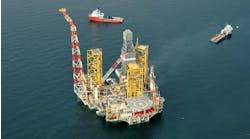Independents increasing presence in GoM
James Dodson, Ted Dodson, James K. Dodson Co.
David Paganie,Senior Editor
Look for operators to bounce back in the GoM in 2006 with healthy E&P budgets driven by strong commodity prices in 2005 and delayed drilling plans resulting from the passage of record-breaking hurricanes during the year.
According to the James K. Dodson Company (Dodson) forecast, a total of 837 wells are forecast to be drilled in 2006, which is a 13% increase over 2005. Of the total number of wells planned for 2006, 672 or about 80% will be drilled in less than 1,500 ft of water, while 165 or 20% will be drilled in 1,500 ft of water or greater.
Of the 672 wells forecast in less than 1,500 ft, 374 or 56% are for development, while 298 or 44% are for exploration drilling. In water depths greater than or equal to 1,500 ft, 54 or 33% of the total number of wells will be drilled for development, while 111 or 67% are planned for exploration.
The total number of wells forecast for exploration in water depths greater than or equal to 1,500 ft indicates the most significant improvement over projected results in 2005, with an additional 35 wells expected to be drilled, which is a 46% increase. The number of wells projected for development in the same water depth will improve by 12, or 29% better than 2005 results.
The total number of wells drilled in less than 1,500 ft of water in 2005 as of October was 519, down 24% from 2004, the Dodson study shows. The total number of exploration wells in the same water depth was down 9% to 223, and development wells drilled were down as well by 36% to 296.
The total number of wells drilled in greater than or equal to 1,500 ft of water through October 2005 was down 38% to 98, exploration wells decreased by 14% to 63, and 80% less development wells were drilled at 35.
A majority of the wells drilled over the last two years were operated by independent oil and gas companies. Of the total number of wells drilled in less than 1,500 of water by the top 20 operators (ranked by count), independents accounted for 88% of the wells. Independents within the top 20 operators ranked in water depths greater than or equal to 1,500 ft accounted for 65% of the total number of wells drilled.
Undrilled leases
The total number of leases held in their primary term that were undrilled with expiration from Dec. 1, 2005 through 2015, totaled 5,695. Independent operators held 3,425 or 60% of the leases, and major operators held 2,270 or 40%. In addition, the number of undrilled primary leases expiring in peak year 2007 amount to 1,250, of which 71% are held by major operators.
Majors hold the majority of undrilled leases in greater than 2,999 ft, held in their primary term every year until 2009, when independents will account for 69% of the total. Independents will then hold the majority through 2015.
There will be a shift in the water depth of undrilled leases expiring in “jackup-level” shallow waters, starting in 2009. Dodson refers to “jackup-level” water depths as those to 350 ft. Leases held in their primary term with expiration will increase every year in this water depth range from 91 in 2005 to 366 in 2009. This will be the first year since 2005 that this water depth range accounts for more undrilled leases expiring than ones held in greater than 3,000 ft.
Production decline
The declining trend in oil and gas production in less than 1,500 ft. water depths continues in the year 2004. The associated production chart illustrates production levels by month in 2004 compared to 2005 through July, which is the last month reported by the MMS at print. The chart also indicates the significant impact to production levels in September 2004 from Hurricane Ivan. Likewise in September 2005, Gulf production was still 30% shut-in from hurricanes Katrina and Rita.
Alternatively, oil and gas production in water depths greater than 1,500 ft showed a steady increase by month through 2004 until September when Hurricane Ivan hit. In 2005, oil and gas production hit its peak in May, which was still below the highest level in 2004. From here production steadily declines through July, which was the last month reported by the MMS, at print.
The gist of the story here is that production in the Gulf is declining. MMS statistics on wellbores and production compiled from 1999 through July 2005 further supports this observation.
The producing status of well intervals reported by MMS data for all wellbores in November 1999 amounted to a total of 16,363, compared to 13,039 total reported in July 2005. Of the 16,363 well intervals in November 1999, 15,444 were in water depths of 600 ft. or less, and 919 in more than 600 ft. of water. For the same water depth, the MMS reported in November 1999 2,602 oil intervals and 2,892 gas intervals producing 194 b/d and 3,163 Mcf/d respectively. In water depths greater than 600 ft., of the 919 well intervals reported, 315 were classified as oil and 155 as gas, producing an average of 2,380 b/d, and 13,592 Mcf/d.
In July 2005, the producing status of 13,059 total well intervals was reported by the MMS in all water depths, a decrease of 3,304 intervals or 20% from November 1999. Of the total reported in July 2005, 12,089 were in water depths of 600 ft. or less, and 970 in more than 600 ft. of water. In the 600 ft. or less water depth range, 4,093 well intervals were reported in a producing status, of which 1,926 were oil, and 2,167 were gas with 7,996 intervals non-producing. Of the producing intervals, oil produced an average of 156 b/d, and gas produced 2,487 Mcf/d.
In more than 600 ft of water, of the 970 intervals reported, 536 were in a producing status. Of the 536 producing intervals, 358 were classified as oil, and 178 as gas, producing an average of 2,661 b/d, and 14,940 Mcf/d. Total non-producing intervals amounted to 434, or 45% of the total 970 in more than 600 ft. of water; compared to 449, or 49% of 919 total reported in November 1999.
Oil production on the shelf in 1999 amounted to 229 Mbbl vs. 168 Mbbl in 2004, and gas produced in 1999 3.8 Tcf vs. 2.4 Tcf in 2004. Oil production decreased 27% and gas 37% from 1999 to 2004. In water depths more than 600 ft., oil in 2004 increased 43% (112 Mbbl) from 351 Mbbl over 239 Mbbl in 1999. Gas in 2004 produced 1.4 Tcf vs. 1.1 Tcf in 1999.
In comparing data through July 2005 to the period through July 1999, and data ending in July 2004, oil and gas volumes produced on the shelf declined from 134 Mbbl in 1999 to 105 Mbbl in 2004, and 87 Mbbl in 2005. Gas volumes declined from 2.3 Tcf in 1999 to 1.4 Tcf in 2004, to 1.2 Tcf in 2005.
Campaign continues
The MMS hopes that its latest ruling for deep shelf drilling will help offset GoM production declines, while contributing a much needed resource for domestic consumption. The MMS reported in late 2004 that it estimates with existing technology about 406 Tcf of natural gas is recoverable from federal offshore areas.
In the regulatory agencies’ latest incentive campaign, it approved a final rule that will allow Suspension of Operations (SOO) to oil and gas leasees or operators who drill ultra-deep wells, beyond 25,000-ft true vertical depth below the ocean’s surface. At print, the rule was scheduled to become effective on January 17.
Basically, the rule allows the operator involved in drilling an ultra-deep well to request a certain period of time for further analysis. The time allocated to the SOO will not reduce the duration of the lease-term but instead - extend it.
“The MMS expects that allowing for SOOs will result in increased domestic production by offsetting the added complexity and cost of drilling ultra-deep wells,” said Johnnie Burton, MMS director. “Information from the industry indicates that large accumulations of hydrocarbons may exist at ultra-deep levels below the ocean surface,” added Burton.
Only time will tell if the increasing influx of independents in the GoM, coupled with the MMS’ vision of massive reservoirs existing well beyond 25,000 ft below the ocean’s surface, will ultimately overturn the seemingly endless trend in declining GoM production.•










